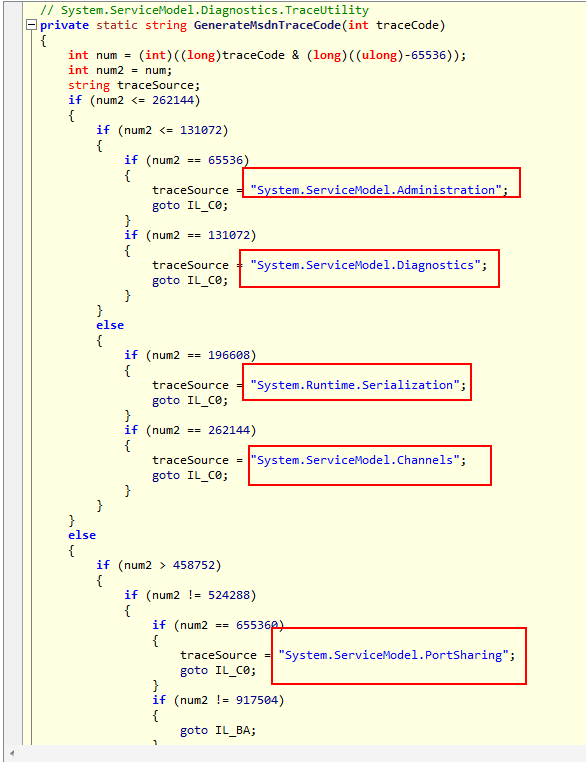十五天精通WCF——第二天 告别烦恼的config配置
经常搞wcf的基友们肯定会知道,当你的应用程序有很多的“服务引用”的时候,是不是有一种疯狂的感觉。。。从一个环境迁移到另外一个环境,你需要改变的
endpoint会超级tmd的多,简直就是搞死了人。。。好了,这篇我们来看看如何最小化配置。
一:精简service的config配置
就像上一篇的代码一样,我的service端的config配置如下:
1 <?xml version="1.0" encoding="utf-8" ?> 2 <configuration> 3 <system.servicemodel> 4 <behaviors> 5 <servicebehaviors> 6 <behavior name="mxbehavior"> 7 <servicemetadata httpgetenabled="true" /> 8 <servicedebug includeexceptiondetailinfaults="true" /> 9 </behavior> 10 </servicebehaviors> 11 </behaviors> 12 <services> 13 <service name="myservice.homeservice" behaviorconfiguration="mxbehavior"> 14 <endpoint address="net.tcp://localhost:1920/homeservice" binding="nettcpbinding" contract="myservice.ihomeservice"> 15 <identity> 16 <dns value="localhost" /> 17 </identity> 18 </endpoint> 19 <endpoint address="mex" binding="mexhttpbinding" contract="imetadataexchange" /> 20 <host> 21 <baseaddresses> 22 <add baseaddress="http://localhost:19200/homeservice"/> 23 </baseaddresses> 24 </host> 25 </service> 26 </services> 27 </system.servicemodel> 28 </configuration>
通过上面的代码,你应该知道在system.servicemodel下的所有节点都是wcf专属的节点,所有的节点数据都会被开启servicehost这个监听器时捕获到,下面我可以
通过servicehost这个监听器的源码下面找找相关的读取config节点的代码。

通过上面的截图,你是不是有一种感觉,就是service的底层也是通过代码动态的读取config下面的节点来获取数据,那就意味着我可以直接将代码写入到code中,
对吧,这样我就可以把我认为该配置的东西配置起来,不该配置的东西全部放到代码里面去,这样我的灵活性是不是非常的强大。。。。爽吧,说干就干。。。
1 class Program1 2 { 3 static void Main(string[] args) 4 { 5 ServiceHost host = new ServiceHost(typeof(HomeService), new Uri("http://localhost:19200/HomeService")); 6 7 host.AddServiceEndpoint(typeof(IHomeService), new NetTcpBinding(), "net.tcp://localhost:1920/HomeService"); 8 9 //公布元数据 10 host.Description.Behaviors.Add(new ServiceMetadataBehavior() { HttpGetEnabled = true }); 11 host.AddServiceEndpoint(typeof(IMetadataExchange), MetadataExchangeBindings.CreateMexHttpBinding(), "mex"); 12 13 host.Open(); 14 15 Console.WriteLine("服务已经开启。。。"); 16 17 Console.Read(); 18 } 19 }
有人就要说了,地址的话肯定不能是写死的,必须变活,简单啊,我就仅仅把ip地址配置到config里面去不就完事了,对不对。
<configuration> <appSettings> <add key ="baseurl" value="http://localhost:19200/HomeService"/> <add key ="endpoindurl" value="net.tcp://localhost:1920/HomeService"/> </appSettings>
1 class Program1 2 { 3 static void Main(string[] args) 4 { 5 ServiceHost host = new ServiceHost(typeof(HomeService), new Uri(ConfigurationManager.AppSettings["baseurl"])); 6 7 host.AddServiceEndpoint(typeof(IHomeService), new NetTcpBinding(), ConfigurationManager.AppSettings["endpoindurl"]); 8 9 //公布元数据 10 host.Description.Behaviors.Add(new ServiceMetadataBehavior() { HttpGetEnabled = true }); 11 host.AddServiceEndpoint(typeof(IMetadataExchange), MetadataExchangeBindings.CreateMexHttpBinding(), "mex"); 12 13 host.Open(); 14 15 Console.WriteLine("服务已经开启。。。"); 16 17 Console.Read(); 18 } 19 }
现在看的话,是不是清楚多了,如果你觉得我的代码比较累赘,你可以封装成一个方法,然后就可以动态的配置nettcp,basic,ws*等等对吧。。。好了,说完服
务端,接下来我们看看client端如何避免。
二:精简client的config配置
就像上一节那样,如果我用“服务引用”的话,vs会偷偷的用svcutil.exe来给我们生成一个proxy类和一个config文件,proxy类也就是你看到的xxxclient。。。
可恶的是config里面会给我生成一些乱七八糟的东西,如下图:
1 <?xml version="1.0" encoding="utf-8" ?> 2 <configuration> 3 <system.serviceModel> 4 <bindings> 5 <netTcpBinding> 6 <binding name="NetTcpBinding_IHomeService" /> 7 </netTcpBinding> 8 </bindings> 9 <client> 10 <endpoint address="net.tcp://localhost:1920/HomeService" binding="netTcpBinding" 11 bindingConfiguration="NetTcpBinding_IHomeService" contract="HomeServiceReference.IHomeService" 12 name="NetTcpBinding_IHomeService"> 13 <identity> 14 <dns value="localhost" /> 15 </identity> 16 </endpoint> 17 </client> 18 </system.serviceModel> 19 </configuration>
同服务器端一样,如果我用code做掉,是不是非常的爽呢???那可不可以做掉呢? 我们还得看一下proxy的源码,首先你会看到其实所谓的proxy只是一个继承
自clientbase的一个类,如下图。


上面的两幅图,你会发现,最后的proxy类是通过ChannelFactory<TChannel>类来完成助攻的,那话说回来了,既然底层用了ChannelFactory<TChannel>,
那何不我在代码里面就用ChannelFactory<TChannel>不是更好吗???这样config也省了,对吧,说干就干啦。。。
1 static void Main(string[] args) 2 { 3 ChannelFactory<IHomeService> factory = new ChannelFactory<IHomeService>(new NetTcpBinding(), "net.tcp://localhost:1920/homeservice"); 4 5 var channel = factory.CreateChannel(); 6 7 var result = channel.GetLength("12345"); 8 }
好了,代码就这么简单,现在是不是感觉自己萌萌大啦~~~


